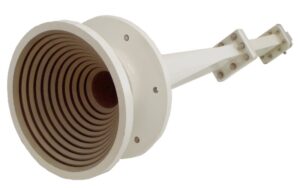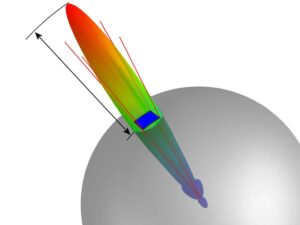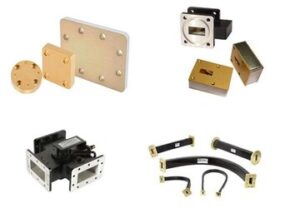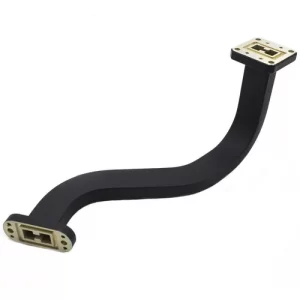Table of Contents
Power class
When the waveguide transmits electromagnetic waves, the higher the transmission power, the greater the heat generated by the waveguide. Waveguides used in laboratory environments transmit microwave signals from 10W to 100W with low heat generation, and in such power ranges the waveguide temperature increases from 5°C to 20°C, which does not require additional cooling systems to work properly. When the power exceeds 500W, the heat caused by the resistance loss in the waveguide will increase significantly, and the temperature rises to 50°C or even higher, then the heat dissipation scheme must be considered to maintain the stability of the system.
The power of ordinary household microwave ovens is between 700W and 1200W, and the thermal load borne by the waveguide is about 10% to 20W. After the waveguide is used for a long time, the temperature rises to 70°C to 90°C, which will significantly shorten the service life of the waveguide, the waveguide life of the microwave oven is 5 to 7 years, if the power is constantly too high, it will be shortened to 3 years.
Waveguide systems for radio broadcasting typically have a power class of 10kW to 50kW, resulting in 50W to 100W of heat per second. These waveguide systems require more complex cooling systems such as water-cooled or air-cooled systems. A 50kW industrial waveguide can generate 1800 joules of heat in an hour, enough to raise the temperature of the waveguide to more than 200°C.
When the power level is at the low end, about 10W to 100W, the transmission efficiency of the waveguide can be maintained at more than 95%. When the power rises to 1kW to 10kW, the transmission efficiency will gradually drop to 90%, and the energy loss is 50W to 100W. In a 10kW system, if the loss reaches 5%, it will lose about 500W of energy per hour, which is equivalent to the power consumption of a medium-sized electrical appliance.
Waveguides for low-power transmission are made of aluminum or lightweight alloy materials, and the cost is lower between 500 yuan and 1000 yuan. High-power waveguides use metals with high thermal conductivity, such as copper or silver, and are twice or even three times as expensive as low-power waveguides. The price of the copper waveguide for transmitting 10kW power is as high as 5,000 to 10,000 yuan. The high-cost design ensures that the waveguide can maintain a service life of up to 10 years in high temperature and pressure environments, which can be reduced to 5 years if not properly maintained.
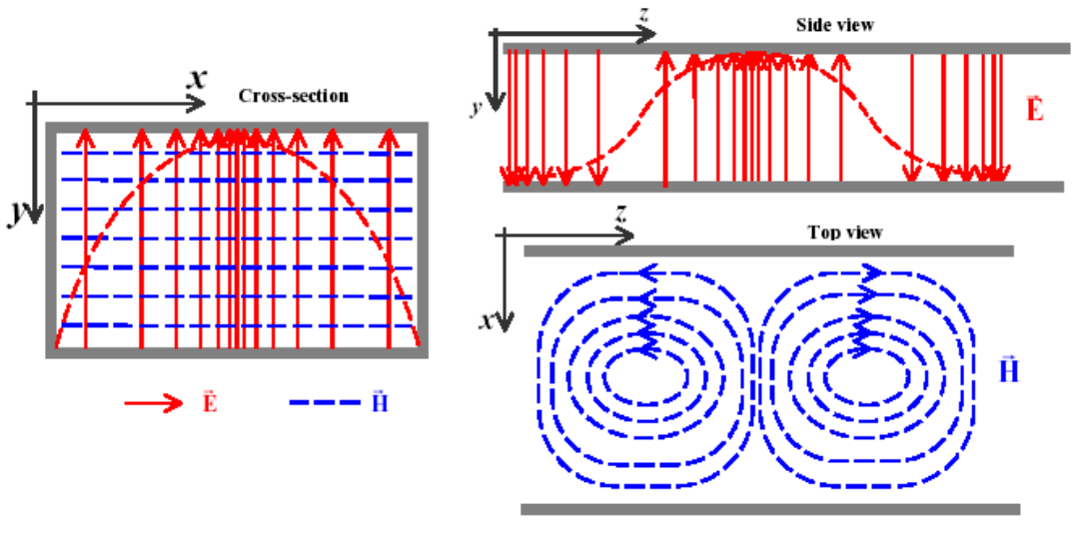
Materials
Common waveguide materials mainly include aluminum, copper, and stainless steel. Aluminum conductivity is about 35 MS/m (megabimens per meter), although not as good as copper, but for the transmission power in the 10W to 100W system, the transmission loss is about 2% to 5%. The price of the waveguide of this material in the market is 500 yuan to 1000 yuan, which is suitable for household microwave equipment or low-power communication equipment.
The price of copper waveguide is 2000 yuan to 5000 yuan, copper conductivity is better, the conductivity is about 58 MS/m, in the transmission power of 1kW or higher system, the loss of copper waveguide is less than 2%, which can significantly reduce the heat. A copper waveguide transmitting 5kW power has an energy loss of 50W per hour and can be maintained between 50°C and 80°C, suitable for long-term continuous operation.
The conductivity of stainless steel is low, about 1.4 MS/m, but its mechanical strength and corrosion resistance are very excellent. Although the loss of stainless steel waveguides is between 10% and 15%, they can withstand extreme climatic conditions and high humidity in harsh outdoor environments. A 50kW stainless steel waveguide for outdoor high-frequency radar loses about 500W of energy per hour, and the temperature rises to about 200°C, requiring an additional cooling system. The price of stainless steel waveguide is higher than 5000 yuan to 10000 yuan, which is suitable for special applications with high requirements.
Although the cost of aluminum waveguide is low, it is easy to oxidized corrosion in long-term high-power operation, especially in a humid environment, and the service life is generally 5 to 7 years. The copper waveguide has better oxidation resistance, and the service life can reach more than 10 years. With the use of high-quality copper materials and regular maintenance, the life of some high-end copper waveguides can even be extended to 15 years or more. Stainless steel waveguides perform best in extreme environments, and their service life can often reach 20 years, especially in corrosive gas or Marine environments.
Aluminum has a thermal conductivity of 205 W/m·K (watts per meter per Kelvin), while copper has a thermal conductivity of 400 W/m·K, which allows copper waveguides to dissipate heat more quickly and avoid local overheating during high power transmission. The thermal conductivity of stainless steel is lower, about 16 W/m·K, so stainless steel waveguides in high power applications require additional heat dissipation measures such as air-cooled or water-cooled systems. In a communication system with a power of 10kW, copper waveguides can maintain temperatures below 70°C without additional cooling equipment, while stainless steel waveguides at the same power need to be equipped with an air cooling system to ensure that the temperature does not exceed 150°C.

Frequency
In the frequency band below 3GHz, the transmission efficiency of the waveguide can be as high as 95%, when the energy loss is small, no more than 5W, and the temperature is kept below 40°C. When the frequency is increased above 10GHz, the transmission loss increases significantly by up to 10% to 20%, which means that for every 100W of power transmitted, 10W to 20W of energy is lost, resulting in a rapid increase in the waveguide temperature.
The frequency commonly used in household equipment such as microwave ovens is 2.45GHz. A 1000W microwave oven has a waveguide efficiency of about 90% and a loss of about 100W. Since the operating time is usually short, the waveguide temperature can be maintained in the range of 60°C to 80°C without excessive loading on the device. If the frequency is increased to 5GHz or higher, the waveguide temperature will exceed 100°C, affecting the service life of the device.
High-frequency waveguides are mainly used in millimeter wave communications, radar systems and other scenarios, and the frequency of such devices is between 24GHz and 40GHz. At such a high frequency, the loss of the waveguide is very obvious, and the loss rate can reach 20% or even higher. Taking a radar system with a frequency of 30GHz as an example, its waveguide loses about 2kW of energy per hour when transmitting 10kW of power, which is equivalent to the power output of a small generator. At this time, the temperature of the waveguide may rapidly rise to about 200°C, and a complex cooling system must be relied on for temperature control, otherwise the waveguide material may overheat and fail.
In low frequency bands such as 1GHz to 3GHz, the size of the waveguide is relatively large, between tens of centimeters and one meter, to ensure that the waveguide can effectively transmit signals. A waveguide operating at 2GHz has a cross section of 10cm×5cm and a length of 50cm to 1m. In the high frequency band such as 30GHz, the size of the waveguide is greatly reduced, its cross section is only 1cm×0.5cm, and the length is also shortened to tens of centimeters. This is because the wavelength of the high-frequency signal is short, and the physical size of the waveguide must be reduced accordingly to suit the transmission needs.
Waveguides operating in low frequency bands are made of aluminum or copper, which not only ensures sufficient conductivity, but also reduces the cost. In the high frequency band, due to the greater sensitivity of electromagnetic waves to the surface of the material, the high-frequency waveguide uses a material with higher conductivity, such as silver or gold-plated surface treatment, to reduce surface loss. Millimeter-wave communication equipment operating at 35GHz, its waveguide adopts silver-plated copper waveguide, conductivity up to 58 MS/m, compared with ordinary copper waveguide, the loss is reduced by about 30%. The manufacturing cost of high-frequency waveguides is also very high, and the price is often 2 or even 3 times that of low-frequency waveguides, and the price of a high-quality high-frequency waveguide is as high as tens of thousands of yuan.
Design and ventilation
The design and ventilation of the waveguide directly affect its heat dissipation performance, and in low-power applications, such as 10W to 100W waveguide devices, a simple passive heat dissipation design is used. Taking a typical aluminum waveguide as an example, aluminum has a thermal conductivity of 205 W/m·K, which can effectively dissipate internal heat to the outside air. For waveguides that transmit 100W of power, the heat dissipation area is about 0.2 square meters, enough to maintain temperatures between 40°C and 50°C, without the need for a complex ventilation system.
When the power level of the waveguide exceeds 1kW, natural ventilation alone can no longer meet the heat dissipation requirements. A 5kW waveguide system used in an industrial environment, due to its heat generation of nearly 500W per hour, if there is no proper ventilation design, the waveguide temperature may rise to 80°C or even higher in a few hours, which will cause the equipment to overheat and damage. In order to reduce the temperature, the common design scheme is to equip the waveguide with an active air cooling system. The air-cooled system provides an air flow rate of about 100 cubic meters per hour, which can maintain the temperature of the waveguide within 60°C.
Waveguides operating at 30GHz, with power levels up to 10kW, may generate more than 1kW of heat per hour. This type of waveguide uses a compact design, the heat dissipation area is small, only 0.1 to 0.15 square meters, so it cannot rely on natural heat dissipation. In order to maintain a stable operating temperature, the common design is to use an air-cooled system in combination with a heat-conducting material. The use of copper waveguide with built-in heat sink, which can improve the heat transfer efficiency. Copper with a thermal conductivity of 400 W/m·K has a heat transfer efficiency of about twice that of aluminum, which can conduct heat to the heat sink in a relatively short time and then be discharged through the air cooling system.
In high power transmission equipment, water cooling system is another common heat dissipation design, for the transmission power of more than 50kW waveguide, relying solely on air cooling often cannot meet the heat dissipation needs. A 50kW waveguide device operating in the 10GHz band has a heat loss of nearly 5kW per hour, and the air-cooled system cannot maintain the temperature within the safe range even if it increases to 300 cubic meters of air flow per hour. Such systems are equipped with a water-cooling system that circulates about 5 litres of water per minute and can reduce the temperature of the waveguide from 120°C to below 70°C. The water cooling system has higher energy efficiency, consumes about 500W per hour, runs at a lower cost than the air cooling system, and the heat dissipation effect is more obvious.
In addition to traditional air-cooled and water-cooled systems, some of the extremely high-power waveguide rate system designs with more than 100kW of power also use liquid metal cooling technology, such as particle accelerators or large satellite communications equipment. Liquid metals such as sodium or potassium have a much higher thermal conductivity than water and can carry away large amounts of heat in a very short time. A 100kW waveguide system using liquid metal cooling technology can reduce temperatures by 20°C to 30°C in just a few seconds.

